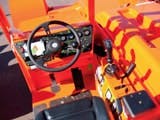Modern ergonomics first emerged in World War II when airplane controls were redesigned to reduce pilot error. Since then, the science of designing machines, products, and systems to maximize safety and comfort has expanded to a number of engineered goods — including construction equipment.
Operator cabs have significantly changed in the past 20 years, moving away from fixed seats and poorly positioned hand controls to suspension seats, ergonomic joysticks, and anatomically correct positioning that enable operators to see the load better, access controls easier, and minimize back strain and fatigue. Overall, ergonomics have allowed operators to work safer and be more productive.
At the Telehandler Showcase, North American telescopic handler manufacturers highlighted features incorporated into their 10,000- to 12,000-pound capacity machines that are designed to enhance comfort. These included improved visibility with the placement of the boom and roof bars, and larger cabs, arm rests, and suspension seats for operator comfort. Right-hand side glass is a standard feature on many telehandlers, which helps to reduce engine noise. Additionally, manufacturers reported different advantages for the placement and use of single multi-function and dual controls, depending on their configuration.
But what ergonomic features do operators like? Phoenix-area telehandler users from the steel erection, masonry, framing, roofing, construction, and demolition industries were surveyed at the Telehandler Showcase during the Operator Event about features and benefits they prefer. Among the questions in the survey were preferences on cab and control configuration. The operator's preferences for open cab or closed cab with heat and air conditioning were split about 50-50. In Phoenix, the reasons are obvious as to why operators would like to sit in a closed cab with AC, but operators who were partial to an open-cab configuration noted there was better visibility, and they were able to hear more in an open cab.
The inclination to use a single multi-function joystick or a dual joystick also was noted during the survey. Two-thirds of the operators preferred single multi-function controls, reporting they liked it because they didn't have to look around for the joystick, enabling them to keep their eyes on the load, and they were able to leave their other hand on the wheel. Those with a bias toward dual joysticks found they were easier to handle, and they could get more functions or options with these controls.





